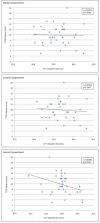Correlation of T2* relaxation times of the retropatellar cartilage with tibial tuberosity-trochlea groove distance in professional soccer players
- PMID: 32948810
- PMCID: PMC7501245
- DOI: 10.1038/s41598-020-72299-7
Correlation of T2* relaxation times of the retropatellar cartilage with tibial tuberosity-trochlea groove distance in professional soccer players
Abstract
The tibial tuberosity-trochlear groove (TT-TG) distance is a radiographic measurement that is used to quantify malalignment of the patellofemoral joint (PFJ) in cross-sectional imaging. There is an ongoing debate about the impact of the TT-TG-distance on lateral patellar instability and the initiating of cartilage degeneration. In this prospective study, the association of T2* relaxation times and TT-TG distances in professional soccer players was analyzed. 36 knees of 18 professional soccer players (age: 21 ± 2.8 years) were evaluated. Participants underwent knee MRI at 3 T. For qualitative image analysis, fat-saturated 2D PD-weighted Fast Spin Echo (FSE) and T1-weighted FSE sequences were used. For quantitative analysis, T2* measurements in 3D data acquisitions were performed. In a qualitative analysis there was no structural cartilage damage and no abnormalities of the patellar and trochlea shape. The highest T2* values (26.7 ± 5.9 ms) were observed in the central compartment of the patella. The mean TT-TG distance was 10 ± 4 mm (range 3-20 mm). There was no significant correlation between TT-TG distance and T2* relaxation times in all three compartments of the retropatellar cartilage. Our study shows that so long as patellar and trochlear morphology is normal, TT-TG distance alone does not affect the tissue structure of the retropatellar cartilage in professional soccer players.
Conflict of interest statement
The authors declare no competing interests.
Figures





Similar articles
-
Tibial tuberosity to trochlear groove distance and its association with patellofemoral osteoarthritis-related structural damage worsening: data from the osteoarthritis initiative.Eur Radiol. 2018 Nov;28(11):4669-4680. doi: 10.1007/s00330-018-5460-9. Epub 2018 Apr 30. Eur Radiol. 2018. PMID: 29713775
-
Correlation of the tibial tuberosity-trochlear groove distance with the Q-angle.Knee Surg Sports Traumatol Arthrosc. 2016 Mar;24(3):915-20. doi: 10.1007/s00167-014-3426-2. Epub 2014 Nov 22. Knee Surg Sports Traumatol Arthrosc. 2016. PMID: 25416671
-
Patellar Tendon-Lateral Trochlear Ridge Distance: A Novel Measurement of Patellofemoral Instability.Am J Sports Med. 2018 Dec;46(14):3400-3406. doi: 10.1177/0363546518809982. Epub 2018 Nov 14. Am J Sports Med. 2018. PMID: 30427701
-
Current evidence advocates use of a new pathologic tibial tubercle-posterior cruciate ligament distance threshold in patients with patellar instability.Knee Surg Sports Traumatol Arthrosc. 2018 Sep;26(9):2733-2742. doi: 10.1007/s00167-017-4716-2. Epub 2017 Sep 16. Knee Surg Sports Traumatol Arthrosc. 2018. PMID: 28918500
-
Healthy knees have a highly variable patellofemoral alignment: a systematic review.Knee Surg Sports Traumatol Arthrosc. 2020 Feb;28(2):398-406. doi: 10.1007/s00167-019-05587-z. Epub 2019 Jun 29. Knee Surg Sports Traumatol Arthrosc. 2020. PMID: 31256215
Cited by
-
Influence of leg axis alignment on MRI T2* mapping of the knee in young professional soccer players.BMC Musculoskelet Disord. 2024 Feb 15;25(1):144. doi: 10.1186/s12891-024-07233-3. BMC Musculoskelet Disord. 2024. PMID: 38360606 Free PMC article.
-
Patellar instability MRI measurements are associated with knee joint degeneration after reconstruction of the medial patellofemoral ligament.Skeletal Radiol. 2022 Mar;51(3):535-547. doi: 10.1007/s00256-021-03832-6. Epub 2021 Jul 4. Skeletal Radiol. 2022. PMID: 34218322 Free PMC article.
-
Effects of long-term running on the structure and biochemical composition of knee cartilage in males: a cross-sectional study.Quant Imaging Med Surg. 2024 Aug 1;14(8):6036-6047. doi: 10.21037/qims-23-1563. Epub 2024 Apr 23. Quant Imaging Med Surg. 2024. PMID: 39144037 Free PMC article.
References
-
- Laurin CA, Levesque HP, Dussault R, Labelle H, Peides JP. The abnormal lateral patellofemoral angle: A diagnostic roentgenographic sign of recurrent patellar subluxation. J. Bone Joint Surg. Am. 1978;60:55–60. - PubMed
-
- Smith TO, Donell ST, Chester R, Clark A, Stephenson R. What activities do patients with patellar instability perceive makes their patella unstable? Knee. 2011;18:333–339. - PubMed
-
- Diederichs G, Issever AS, Scheffler S. MR imaging of patellar instability: Injury patterns and assessment of risk factors. Radiographics. 2010;30:961–981. - PubMed
-
- Fithian DC, Paxton EW, Stone ML, Silva P, Davis DK, Elias DA, et al. Epidemiology and natural history of acute patellar dislocation. Am. J. Sports Med. 2004;32:1114–1121. - PubMed
-
- Chan VO, Moran DE, Mwangi I, Eustace SJ. Prevalence and clinical significance of chondromalacia isolated to the anterior margin of the lateral femoral condyle as a component of patellofemoral disease: Observations at MR imaging. Skeletal. Radiol. 2013;42:1127–1133. - PubMed
Publication types
MeSH terms
LinkOut - more resources
Full Text Sources
Medical
Miscellaneous

